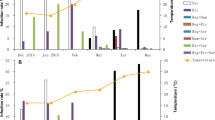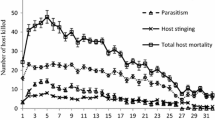Abstract
Life history traits of gypsy moth larvae markedly decrease under the effect of host plant insect resistance, but no significant changes occur in immunity parameters such as hemolymph phagocytic activity and lysozyme-like activity of hemolymph plasma and midgut tissue; moreover, alkaline protease activity in the midgut contents becomes higher. The actual sensitivity of the larvae to Bacillus thuringiensis remains unchanged.
Similar content being viewed by others
References
Lazarevic, J., Peric-Mataruga, V., Stojkovic, B., and Tucic, N, Adaptation of the gypsy moth to an unsuitable host plant, Entomol. Exp. Appl., 2002, vol. 102, pp. 75–86.
Feeny, P.P, Seasonal changes in oak leaf tannins and nutrients as a cause of spring feeding by winter moth caterpillars, Ecology, 1970, vol. 51, pp. 565–581.
Martemyanov, V.V., Pavlushin, S.V., Dubovskiy, I.M., et al., Asynchrony between host plant and insects-defoliator within a tritrophic system: The role of herbivore innate immunity, PLOS ONE, 2015, vol. 10, no. 6, e0130988.
Larson, S., Resistance in trees to insects: An overview of mechanisms and interactions, in Mechanisms and Development of Resistance in Trees to Insects, Wagner, M.R., Clancy, K.M., Lieutier, F., and Paine, T.D., Eds., Netherlands: Kluwer, 2002, pp. 1–29.
Haukioja, E., Tree defenses against insects, in Multigenic and Induced Systemic Resistance in Plants, Bent, E. and Tuzun, S., Eds., New York: Springer, 2006, pp. 279–295.
Dicke, M. and Baldwin, I.T., The evolutionary context for herbivore-induced plant volatiles: Beyond the ‘cry for help,’ Trends Plant Sci., 2010, vol. 15, pp. 167–175.
Cory, J.S. and Hoover, K., Plant-mediated effects in insect–pathogen interactions, Trends Ecol. Evol., 2006, vol. 21, no. 5, pp. 278–286.
Martemyanov, V.V., Dubovskiy, I.M., Belousova, I.A., et al., Rapid induced resistance of silver birch affects both innate immunity and performance of gypsy moths: The role of plant chemical defenses, Arthropod Plant Interact., 2012, vol. 6, pp. 507–518.
Osier, T.L., Hwang, S.-Y., and Lindroth, R.L, Effects of phytochemical variation in quaking aspen, Populus tremuloides, clones on gypsy moth, Lymantria dispar, performance in the field and laboratory, Ecol. Entomol., 2000, vol. 25, pp. 197–207.
Wratten, S.D., Edwards, P.J., and Dunn, I, Woundinduced changes in the palatability of Betula pubescens and B. pendula, Oecologia, 1984, vol. 61, pp. 372–375.
Parry, D., Herms, D.A., and Mattson, W.J, Responses of an insect folivore and its parasitoids to multiyear experimental defoliation of aspen, Ecology, 2003, vol. 84, pp. 1768–1783.
Lee, K.P., Cory, J.S., Wilson, K., et al., Flexible diet choice offsets protein costs of pathogen resistance in a caterpillar, Proc. R. Soc. B, vol. 273, pp. 823–829.
Dubovskiy, I.M., Krukova, N.A., and Glupov, V.V, Phagocytic activity and encapsulation rate of Galleria mellonella larvae hemocytes during bacterial infection by Bacillus thuringiensis, J. Invertebr. Pathol., 2008, vol. 88, pp. 360–362.
Naveh, V.H., Bandani, A.R., Azmayeshfard, P., and Hosseinkhani, S, Digestive proteinase activity of the Khapra beetle, Trogoderma granarium Everts (Coleoptera: Dermestidae), Commun. Agric. Appl. Biol. Sci., 2005, vol. 70, no. 4, pp. 879–882.
Garcia-Carreno, F.L., Dimes, L.E., and Haard, N.F., Substrate-gel electrophoresis for composition and molecular weight of proteinases or proteinaceous proteinase inhibitors, Anal. Biochem., 1993, vol. 214, no. 1, pp. 65–69.
Martemyanov, V.V., Dubovskiy, I.M., Rantala, M.J., et al., The effects of defoliation-induced delayed changes in silver birch foliar chemistry on gypsy moth’s performance, immune responses and resistance against baculovirus, J. Chem. Ecol., 2012, vol. 38, no. 3, pp. 295–305.
Tetreau, G., Stalinski, R., David, J.P., and Despres, L, Increase in larval gut proteolytic activities and Bti resistance in the dengue fever mosquito, Arch. Insect Biochem. Physiol., 2013, vol. 82, no. 2, pp. 71–83.
Farrar, R.R., Martin, P.A.W., and Ridgway, R.L, Host plant effects on activity of Bacillus thuringiensis against gypsy moth (Lepidoptera: Lymantriidae), Environ. Entomol., 1996, vol. 25, no. 5, pp. 1215–1223.
Broderick, N.A., Goodman, R.M., Handelsman, J., and Raffa, K.F, Effect of host diet and insect source on synergy of gypsy moth (Lepidoptera: Lymantriidae) mortality to Bacillus thuringiensis subsp. kurstaki by Zwittermicin A, Environ. Entomol., 2003, vol. 32, no. 2, pp. 387–391.
Bakhvalov, S.A., Koltunov, E.V., and Martem’yanov, V.V., Faktory i ekologicheskie mekhanizmy populyatsionnoi dinamiki lesnykh nasekomykh-fillofagov (Factors and Ecological Mechanisms of the Population Dynamics of Forest Phyllophagous Insects), Novosibirsk: Sib. Otd. Ross. Akad. Nauk, 2010.
Felton, G.W. and Gatehouse, J.A., Antinutritive plant defence mechanisms, in Biology of the Insect Midgut, Lehane, M.J. and Billingsley, P.F., Eds., London: Chapman and Hall, 1996, pp. 373–416.
Author information
Authors and Affiliations
Corresponding author
Additional information
Original Russian Text © I.A. Belousova, V.V. Martemyanov, V.V. Glupov, 2017, published in Ekologiya, 2017, No. 2, pp. 100–106.
Rights and permissions
About this article
Cite this article
Belousova, I.A., Martemyanov, V.V. & Glupov, V.V. The role of rapid induced resistance of host plant in trophic interactions between Betula pendula, Lymantria dispar, and Bacillus thuringiensis . Russ J Ecol 48, 116–121 (2017). https://doi.org/10.1134/S1067413617020047
Received:
Published:
Issue Date:
DOI: https://doi.org/10.1134/S1067413617020047




